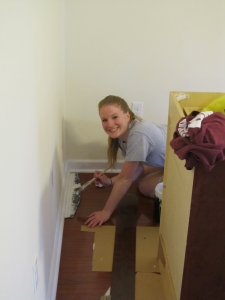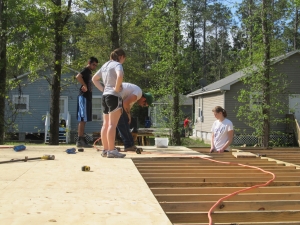I deeply miss the opportunity to have my students work in New Orleans with Operation Helping Hands. It’s not that the work is far different from what we are doing this week, but for the purposes of the New Orleans course, the chance to work in the neighborhoods and learn the streets, meet and talk to the people, and have them stop and thank you (and talk some more) is very important. And the young, full-time volunteers, most of them just out of college themselves, were fun to work with and provided my students with good role models.

Habitat for Humanity homes outside of Abita Springs, LA, March 2012.
That said, the experience of working with the two Habitat agencies in St. Tammany Parish and the housing at the Peace Mission Center has been great. The volunteer coordinators have been informative, helpful, and welcoming. And as always, I am amazed at the construction heads, crew chiefs, etc. that Habitat is able to put on site. They are born teachers; they are patient (to a remarkable degree), quick to assess skill levels, and always looking to make the experience a meaningful one for the volunteers. And it helps that I have a cracker jack group this year who are threatening to leave next week’s volunteers with nothing to do.
 And, as anyone who knows me can tell you, I love visiting and learning about new places. For fear of online retribution, I will not list the handful of places for which this is not true. I’ll just leave it at that. Slidell has been a pleasure. The food is good, the people are friendly and almost as welcoming as those down the road in New Orleans, but we’re talking gold standard here. The terrain is pleasant, although I could do without all of the strip malls. I realize that this is, for the most part, a national epidemic, but it does seem that my native-South has perfected the blight.
And, as anyone who knows me can tell you, I love visiting and learning about new places. For fear of online retribution, I will not list the handful of places for which this is not true. I’ll just leave it at that. Slidell has been a pleasure. The food is good, the people are friendly and almost as welcoming as those down the road in New Orleans, but we’re talking gold standard here. The terrain is pleasant, although I could do without all of the strip malls. I realize that this is, for the most part, a national epidemic, but it does seem that my native-South has perfected the blight.
Yesterday, I had the opportunity to follow one of our groups over to their work with Habitat for Humanity St. Tammany–West. The work site was just outside of Abita Springs, which until then was just a name on one of my favorite regional beers (their Turbodog, to be exact, but their amber is good, too). It is a beautiful little community, just north of Mandeville. They’ve preserved much of their downtown, complete with tin roofed buildings, undisturbed trees, and locally-owned businesses.

Painting trim, Abita Springs LA, March 2012
The Habitat build was just to the west, and as you pulled off of the main road, you see a whole community, largely built by Habitat for Humanity. One of the crew estimates that nearly seventy homes in this area alone have been built by Habitat over the past two decades. That’s right. Before Katrina. We sometimes forget that events like Katrina, this spring’s tornadoes, etc. do not cause a shortage of quality, affordable housing in the richest country in the world, they only exacerbate it. And such events hopefully highlight the need for those who would rather forget about that fact. Habitat for Humanity does not forget. Their mission is to alleviate it, one house and one deserving family at a time.

Installing sub-flooring at homesite on Tupelo Street, Slidell LA, March 2012
The students were working with a wonderful crew of professional builders, young people, and those unable to truly retire, not becuase of economic need, but because they care. And the students, whether they realized it or not, had been paid a very high complement. The house they were working on was about to be turned over to a family, who had also had to put in considerable sweat equity — a Habitat requirement. There was a punchlist of items that had to be done before the papers are signed and usually, becuase these tasks can seem rather random, yet time sensitive, a crew member usually completes them. However, our group so impressed on Tuesday that they were there completing the punchlist: touching up trim and walls, installing screens; removing debris from the yard and shed; and pouring cement landings in front and back. It will be interesting to see what they are allowed to do the rest of the week.
The two groups working for St. Tammany-East Habitat for Humanity are not being left in the dust by the other. They are laying sub-flooring at one site, painting porches on completed homes, and power-washing in preparation for future paint jobs. The construction manager is complaing that they are moving so fast that he is worried about having work to do for the 32 volunteers arriving next week. He is giving them a late start on Friday; 10:00, rather than 6:45 a.m. I suspect it is both reward and an attempt to slow them down a bit. Needless to say, given the performance of this year’s class, both volunteer coordinators are eager to have us sign on for next year. And I just might.
After work, students returned to the Peace Mission Center for warm showers, some online time, to write in their journals (remember those journals!) and to shoot baskets or throw a football. They had very satisfying chicken pot pie and for those so inclined, veggie burgers, for dinner. For dessert was angel food cake with freshly made blueberry or strawberry sauce.

Left to right, Dr. Michael White, Kerry Lewis, Gregg Stafford, and Detroit Brooks, Xavier University, March 2012
After dinner, we drove across New Orleans to Xavier University of Louisiana for our annual fix of traditional jazz. There we met with Dr. Michael White, jazz clarinetist, composer, bandleader and holder of the Keller Endowed Chair in the Humanities of New Orleans Music and Culture. He and his quartet, which includes Kerry Lewis on bass, Detroit Brooks on banjo, and Gregg Stafford on trumpet and vocals, led us on a musical journey from the beginnings of jazz in New Orleans, up through one of Michael’s new compositions in the traditional idiom. I was especially taken with White’s channeling of Sidney Bechet while playing Gershwin’s “Summertime” and the ensemble’s performance of a newer composition “Give it Up” (Gypsy Second Line), a traditional-style tune with a hint of Eastern European flavor. One of my favorites. It was fun to see the recognition on the students’ faces when they played “Basin Street Blues” with Gregg Stafford on vocals. It was one of the ten tunes they had to learn for their mid term, just a week ago back in Durham.
We were joined by Joonhyung and Desiree Cho. Joon has a masters degree from UNH and works in the intellectual property division of the LSU Agricultural Experiment Station. They had attended the conert with us before, but Joon, is known to the the class as the guy who provides us with a king cake during Carnival season. Last night, he also brought each student a small package of LSU-licensed rice. All he and Desiree got was good music and a pair of “UNH–New Orleans” tee shirts.

Walter "Wolfman" Washington, d.b.a., March 2012.
After the concert, you could see that the fatigue of the past two days had really set in. A small group of intrepid cultural warriors headed into the City, but most chose to make their way across the lake to the relative comfort of our base in Slidell. I went to Frenchmen Street where I caught a long and enjoyable set by bluesman Walter “Wolfman” Washington at d.b.a. It was tempting to stay for another, but as with the others, the Northshore beckoned.
Leave a Response »








































